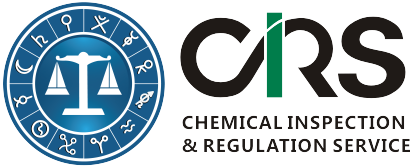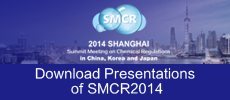Modification in the Data Requirement of the Draft of Revised Guidance for New Chemical Substance Notification in China
original article from CIRS
In this article, CIRS experts have compiled the data requirement difference between the current Guidance and the draft of the revised Guidance.
Data Requirement
IECIC 2014 was finalized on 30 Jun 2014 after two times’ consultation in public.
1. Physicochemical Data
a. Gas State: None
b. Liquid State: Closed cup method will be required for the flash point determination
c. Solid State: None
The following information shall be included in the attachment when submission: Spectrum Data for organics shall include at least two spectrums of IR, NMR and MS; Spectrum Data for chiral material shall include optical rotation information. Testing condition information shall also be included when submission.
2. Toxicology
a. Acute Toxicology: for Level 1, the testing data of acute oral toxicity, skin irritation, eye irritation and skin sensitization shall be submitted; the data submission of acute percutaneous toxicity and acute inhalation toxicity shall be according to physicochemical properties and major exposure ways. (The revision reveals the possibility of exempting the data submission of acute percutaneous toxicity and acute inhalation toxicity)
b. Mutagencity: for Level 1, two in vitro testing data shall be performed, if one of which is positive with high exposure risks, a higher level of mutagencity testing data will be required to be submitted. For Level 2, staged mutagencity testing shall be added according to the results of the two in vitro tests; an extra testing data of in vitro genetic mutation or several sets of in vivo mutagencity testing data shall be submitted. (The revision reveals that the mutagencity data requirement is getting more similar to REACH that staged tests are required and in vitro tests shall be carried out first.)
c. 90-day repeated dose test: for Level 2, if 28-day testing data shows negative or toxicokinetics testing data shows possibility of accumulation, submission of 90-day data is required.
d. Reproduction/development toxicity: No significant changes.
e. Toxicokinetics: for Level 2, submission of toxicokinetics related information will be required (not only absorption kinetics); for Level 3, if substance health hazard has no classification (no hazardous), only toxicokinetics related information is needed; for Level 3, if substance health hazard has classification (hazardous), a full set of toxicokinetics testing report is required. (Revision reveals more specific and detailed data requirement for toxicokinetics.)
f. Chronic toxicity: None.
g. Carcinogenicity: submission of carcinogenicity data is required if the substance has widely spread uses; is frequently or long-term exposed to human body; belongs to germinal mutagenicity category 2 or has been approved in the repeated dose test that the substance can cause hyperplasia or cancer. If none of the above situation is fulfilled, the enterprises can, instead, submit carcinogenicity assessment report; however, after the assessment, the submission of carcinogenicity data will be required if the assessment result shows that the carcinogenicity tests are required. (Revision reveals the possibility of exemption of most non-carcinogenic substance)
3. Eco-toxicology
a. Fish 14-day toxicity: for Level 2, the test has been removed and no other test added. (Good news for enterprises)
b. Earthworm reproduction test: newly added. For Level 4, the earthworm reproduction test will be required if terrestrial organism acute toxicity test results have hazardous classification. (Increase difficulty for Level 4 notification)
Special Requirement
1. Data requirement for special substance
a. Pyrophoric substance: density determination data (current requirement) and (eco) toxicology data from estimation, read-across or scientific paper (newly added) will be required to be submitted.
b. Other requirement: none.
2. Data requirement for other special situations
a. Eco-toxicology test completed in China: no significant changes
b. Terrestrial organism toxicology data: testing data is recommended to be submitted for substance with soil environmental risk. (Previous situation: for insoluble compound, if aquatic organism toxicology tests have been completed in oversea countries, data of terrestrial organism toxicology can be submitted.)
c. Testing samples: no significant changes
d. Impurities: none
Data Exemption Conditions
(Only modified exemption conditions are listed below)
1. Physicochemical Data
a. Pyrophoric temperature: the definition of the inflammable liquid in air is added: substances that are inflammable liquid or liquid flash point higher than 200 ℃. (The exemption condition is more clear and detailed)
2. Toxicology Data
a. Acute percutaneous toxicity: exemption condition added: skin corrosivity. (Exemption condition added)
b. Acute inhalation toxicity: exemption condition modified: substance with temperature of 20℃ and vapor pressure of less than 10-1 Pa. (Vapor pressure was 10-2 Pa, good news for enterprises)
c. 90-day repeated dose toxicity: exemption condition added: 1. Same testing animal and testing method are used in the 28-day repeated dose toxicity test and toxic effect is shown or the level of “non-observable effect” is low. (This condition covers level 2,3,4 notifications, good news for enterprises) 2. Carcinogenic substance of category 1 or 2. (Newly added)
d. Carcinogenicity: exemption condition modified: when substances belong to germinal mutagenic 1A or 1B, or have already done joint test of chronic toxicity and carcinogenicity.
e. Chronic toxicity: exemption condition modified: substance already have done joint test of chronic toxicity and carcinogenicity can be exempted. (Higher requirement)
3. Eco-toxicology data
a. Algae acute toxicity, daphnia acute toxicity, fish acute toxicity and daphnia reproduction: exemption condition description added: testing report of biological membrane penetration of the substance is required to be provided, or prediction data shall be provided when testing is impossible.
b. Terrestrial organism toxicity: exemption condition description added: “soil adsorbability is low, which means Log Koc is smaller than 1.5” (More specific)
Adsorbability/Desorbability: exemption condition description added: hydrolysis half-life period less than 12 hours. (More specific)
Contact Us
- CIRS China
Hangzhou CIRS Co. Ltd (CIRS China)
11F Building 1, Dongguan Hi-Tech Park, 288 Qiuyi Road, Binjiang District, Hangzhou 310052, China
Tel: +86-571 8720 6574 | Fax: +86-571 8720 6533
Email: service@cirs-reach.com

